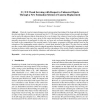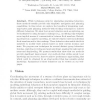208 search results - page 34 / 42 » How can a robot have consciousness |
IJSE
2010
13 years 4 months ago
2010
Affective computing has proven to be a viable field of research comprised of a large number of multidisciplinary researchers resulting in work that is widely published. The majori...
ICML
1998
IEEE
14 years 8 months ago
1998
IEEE
Stochastic topological models, and hidden Markov models in particular, are a useful tool for robotic navigation and planning. In previous work we have shown how weak odometric dat...
ICRA
2002
IEEE
14 years 15 days ago
2002
IEEE
When assembling MEMS devices or manipulating biological cells it is often beneficial to have information about the force that is being applied to these objects. This force informa...
IJCV
2000
13 years 7 months ago
2000
Classical visual servoing techniques need a strong a priori knowledge of the shape and the dimensions of the observed objects. In this paper, we present how the 2 1/2 D visual serv...
SAB
2004
Springer
14 years 28 days ago
2004
Springer
While techniques exist for simulating swarming behaviors, these methods usually provide only simplistic navigation and planning capabilities. In this review, we explore the benefi...


